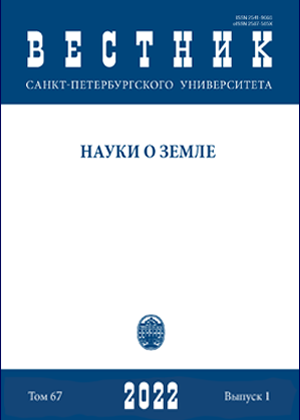Dynamics of intraregional features of migration of the population of the Stavropol Territory
DOI:
https://doi.org/10.21638/spbu07.2022.109Abstract
Using official statistics, this article carries out an historical and geographical analysis of factors and trends of migration processes of the population of the Stavropol Territory over the past 60 years in order to identify intra-regional features of population migration (at the level of cities and districts). The main research tools are analytical, cartographic, historical reconstruction, statistical, comparative geographical, and comparative historical methods. The study also used scientific literature, archival statistical data from the North Caucasus Statistical Service, and materials from a sociological survey. The time period according to characteristics of factors, trends, and forms of population migration in Russia was divided into three parts: the last three Soviet decades (1963–1991); forced migration (1992–2000); and contemporary (2001–2019). The study revealed the transformation of population migration at each of the considered periods. The article focuses on identifying dynamics of coefficients of migration growth in cities and districts of the Stavropol Territory at different periods. The main regularity of the intraregional features of population migration in the Stavropol Territory is a gradual increase in the area of territories with negative migration performance, which was natural for agro-industrial Stavropol in the conditions of the classical stage of urbanization, and which was characterized by significant migrations of the rural population to cities. This pattern was interrupted in the 1990s, when stress factors were at work, and the opposite trend was noted. However, in the contemporary period, the growth of cities and regions with a migration decline has become a defining trend. Today, only territories included in the Stavropol and Caucasian Mineral Waters urban agglomerations have migration attractiveness in the Stavropol Territory. Thus, in the contemporary period there has been an increase in the importance of the position of territories in the “core-semi-periphery-periphery” system, as well as an increase in the socio-economic spatial polarization of Russia and its regions. The revealed patterns and tendencies of migration processes in the Stavropol Territory "fit" into the broad context of V. Zelinsky's theory of mobile transition, which is natural in the context of the change of the industrial era with a post-industrial society.
Keywords:
spatial and temporal features migrations, migration processes of the population, Stavropol Territory
Downloads
References
Аверкиева, К. В., Антонов Е. В., Кириллов П. Л., Махрова А. Г., Медведев А. А., Неретин А. С., Нефедова Т. Г., Трейвиш, А. И. (2016) Между домом… и домом. Возвратная пространственная мобильность населения России. М.: Новый хронограф, 27, 29, 38, 48.
Антонов, Е. В., Махрова, А. Г. (2019). Крупнейшие городские агломерации и формы расселения надагломерационного уровня в России. Известия Российской академии наук. Серия географическая, 4, 31–45.
Белозеров, В. С. (1997). Кавказские Минеральные Воды: эволюция системы городов эколого-курортного региона. Серия. Россия 90-х: проблемы регионального развития. М.: Ваш Выбор. ЦИРЗ, 4–5, 64.
Белозеров, В. С. (2000). Этнодемографические процессы на Северном Кавказе. Ставрополь: СГУ, 5, 8–12, 23–25.
Белозеров, В. С., Белозерова, Л. П. (2011). Миграционные процессы на Ставрополье: города. В: Миграции и пространственная мобильность в сельско-городском континууме России в XX веке: управляемость, адаптивность и стратегии преодоления. Российско-немецкая научная конференция (Ставрополь, 16–18 июня 2011 г.): сборник рабочих материалов. Ставрополь: изд-во СГУ, 275–287.
Вакуленко, Е. С. (2015). Эконометрический анализ факторов внутренней миграции в России. Региональные исследования, 4, 83–95.
Зайончковская, Ж. А. (1999) Россия: миграция в разном масштабе времени. Научные доклады Центра изучения проблем вынужденной миграции в СНГ и Независимого исследовательского Совета по миграции стран СНГ и Балтии. М., 1, 8–26.
Зубаревич, Н. В. (2017). Развитие российских агломераций: тенденции, ресурсы и возможности управления. Общественные науки и современность, 6, 5–21.
Карачурина, Л. Б., Мкртчян, Н. В. (2013). Изменение численности населения муниципальных образований РФ (1989–2010 гг.): центро-периферийные взаимодействия. Вопросы географии, 135, 82–107.
Мкртчян, Н. В., Карачурина, Л. Б. (2021). Внутрирегиональная миграция населения в России: пригороды выигрывают у столиц. Известия Российской академии наук. Серия географическая, 1, 24–38. https://doi.org/10.31857/S2587556621010076
Нефедова, Т. Г., Мкртчян, Н. В. (2017). Миграция сельского населения и динамика сельскохозяйственной занятости в регионах России. Вестник Московского университета. Серия 5, 5, 58–67.
Нефедова, Т. Г. (2012). Сельское Ставрополье глазами московского географа. Разнообразие районов на юге России. Ставрополь: СГУ, 9–12.
Рыбаковский, Л. Л. (2001). Миграция населения. Стадии миграционного процесса, 5 [книга], М.
Рязанцев, С. В. (2003). Современный демографический и миграционный портрет Северного Кавказа. Ставрополь: Сервисшкола.
Соловьев, И. А. (2004). Региональные особенности современных миграционных процессов на Северном Кавказе. Диссертация.… канд. географ. наук. Ставропольский государственный университет.
Ставропольский край в истории СССР (1975). Ставрополь: книжное изд-во, 246, 271.
Трейвиш, А. И. (2016). Сельско-городской континуум: судьба представления и его связь с пространственной мобильностью населения. Демографическое обозрение, 3 (1), 52–70.
Черкасов, А. А. (2016.) Этнические аспекты урбанизации в России. Ставрополь: ФОК-Юг, 48–51.
Щитова, Н. А., Чихичин, В. В. (2014). Этнические черты миграционных процессов и проблемы адаптации мигрантов на Ставрополье. В: Миграционные процессы: проблемы адаптации и интеграции мигрантов: сборник материалов Международной научно-практической конференции, под ред., В. С. Белозерова. Ставрополь: Изд-во СКФУ, 297–304.
Щитова, Н. А., Белозеров, В. С., Турун, П. П., Эшроков, В. М. (2003). Этнические особенности миграционного поведения и адаптации населения в Ставропольском крае. Вестник Московского университета. Серия 5. География, 4, 52–57.
Wallerstein, I. (1984). The Politics of the World Economy: The States, the Movements, and the Civilisations. Cambridge University Press, Cambridge.
Ravenstein, E. G. (1885). The Laws of Migration. Jornal of the Royal Statistical Society, 48, 167–235.
Ussrdoc.narod.ru (2021). Система доступа к базе всех нормативно-правовых актов Союза Советских Социалистических Республик [online]. Доступно на: http://www.ussrdoc.com/ussrdoc_communizm/usr_6093.htm [Дата доступа 09.12.2021].
Zelinsky, W. (1971). The hypothesis of the mobility transition. Geographical Review, 61, 219–249.
Downloads
Published
How to Cite
Issue
Section
License
Articles of "Vestnik of Saint Petersburg University. Earth Sciences" are open access distributed under the terms of the License Agreement with Saint Petersburg State University, which permits to the authors unrestricted distribution and self-archiving free of charge.






